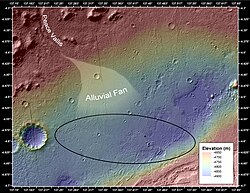 Peace Vallis and related alluvial fan near the Curiosity rover landing ellipse and landing site (Bradbury Landing) (noted by cross [+]). | |
| Coordinates | 4°13′S 137°14′E / 4.21°S 137.23°E |
|---|---|
| Length | 35.24 km (21.90 mi) |
| Naming | Adopted by the IAU on September 26, 2012, after the Peace River in British Columbia and Alberta, Canada.[1] |
Peace Vallis is an ancient stream valley on the northern rim of Gale Crater on the planet Mars. It is notable for its associated alluvial fan which lies near the Mars Science Laboratory Curiosity landing site (Bradbury Landing). The valley and alluvial fan provide evidence for geologically recent (Amazonian-aged) fluvial activity[2][3] and sustained water flow[4] on Mars. Recent high-resolution orbital images of Peace Vallis and its watershed also suggest that at least one glacial episode affected Gale crater.[5] All of this evidence has implications for the history of water on Mars and the planet's long-term habitability.[6] Understanding Peace Vallis and its fan also provides geologic context for the rocks observed on the ground by the Curiosity rover.[7]
- ^ "Gazetteer of Planetary Nomenclature: Peace Vallis". IAU. September 26, 2012. Retrieved September 28, 2012.
- ^ Newsom, H.E.; Scuderi, L.A.; Gallegos, Z.E.; Williams, J.M.; Dimitracopoulos, F.D.; Tornabene, L.L.; Wiens, R.C.; Gasnault, O. (2021). Evidence for Glacial and Fluvial Processes on Gale Crater Rim—Dulce Vallis. 52nd Lunar and Planetary Science Conference, Abstract #2256. https://www.hou.usra.edu/meetings/lpsc2021/pdf/2256.pdf.
- ^ Ehlmann, Bethany L.; Buz, Jennifer (January 28, 2015). "Mineralogy and fluvial history of the watersheds of Gale, Knobel, and Sharp craters: A regional context for the Mars Science Laboratory Curiosity's exploration". Geophysical Research Letters. 42 (2): 264–273. doi:10.1002/2014GL062553. ISSN 0094-8276.
- ^ Williams, R.M.E.; Grotzinger, J.P.; Dietrich, W.E.; Gupta, S.; Sumner, D.Y. et al. (2013). Martian Fluvial Conglomerates at Gale Crater. Science, 340, 1068, doi: 10.1126/science.1237317.
- ^ Newsom, H.E.; Scuderi, L.A.; Gallegos, Z.E.; Tornabene, L.L.; Wiens, R.C. (2020). Evidence for Glacial Processes on Gale Crater Rim Surfaces from New HiRise Observations. 51st Lunar and Planetary Science Conference, Abstract #2609. https://www.hou.usra.edu/meetings/lpsc2020/pdf/2609.pdf.
- ^ Scuderi, L.A.; Gallegos, Z.E.; Newsom, H.E.; Wiens, R..C. (2019). Amazonian Groundwater Springline at Peace Vallis Fan, Gale Crater; Implications for a Late Period of Surface Habitability. Mars Extant Life: What's Next? Conference, Abstract #5043. https://www.hou.usra.edu/meetings/lifeonmars2019/pdf/5043.pdf.
- ^ Palucis, M.C.; Dietrich, W.E.; Hayes, A.; Williams, R.M.E. et al. (2013). Origin and Evolution of the Peace Vallis Fan System that Drains into the Curiosity Landing Area, Gale Crater. "44th Lunar and Planetary Science Conference", Abstract #1607. https://www.lpi.usra.edu/meetings/lpsc2013/pdf/1607.pdf.